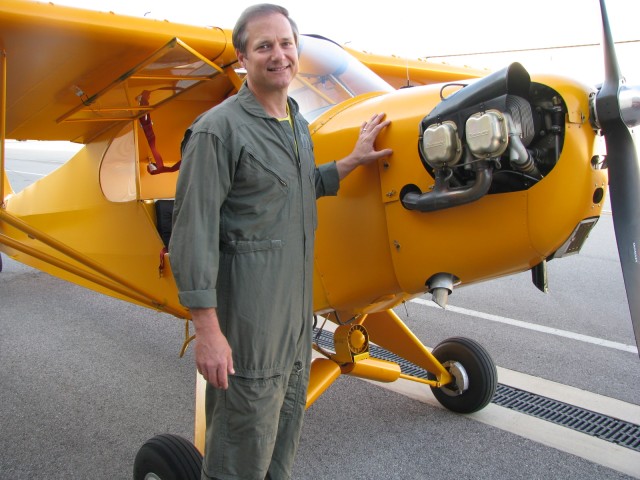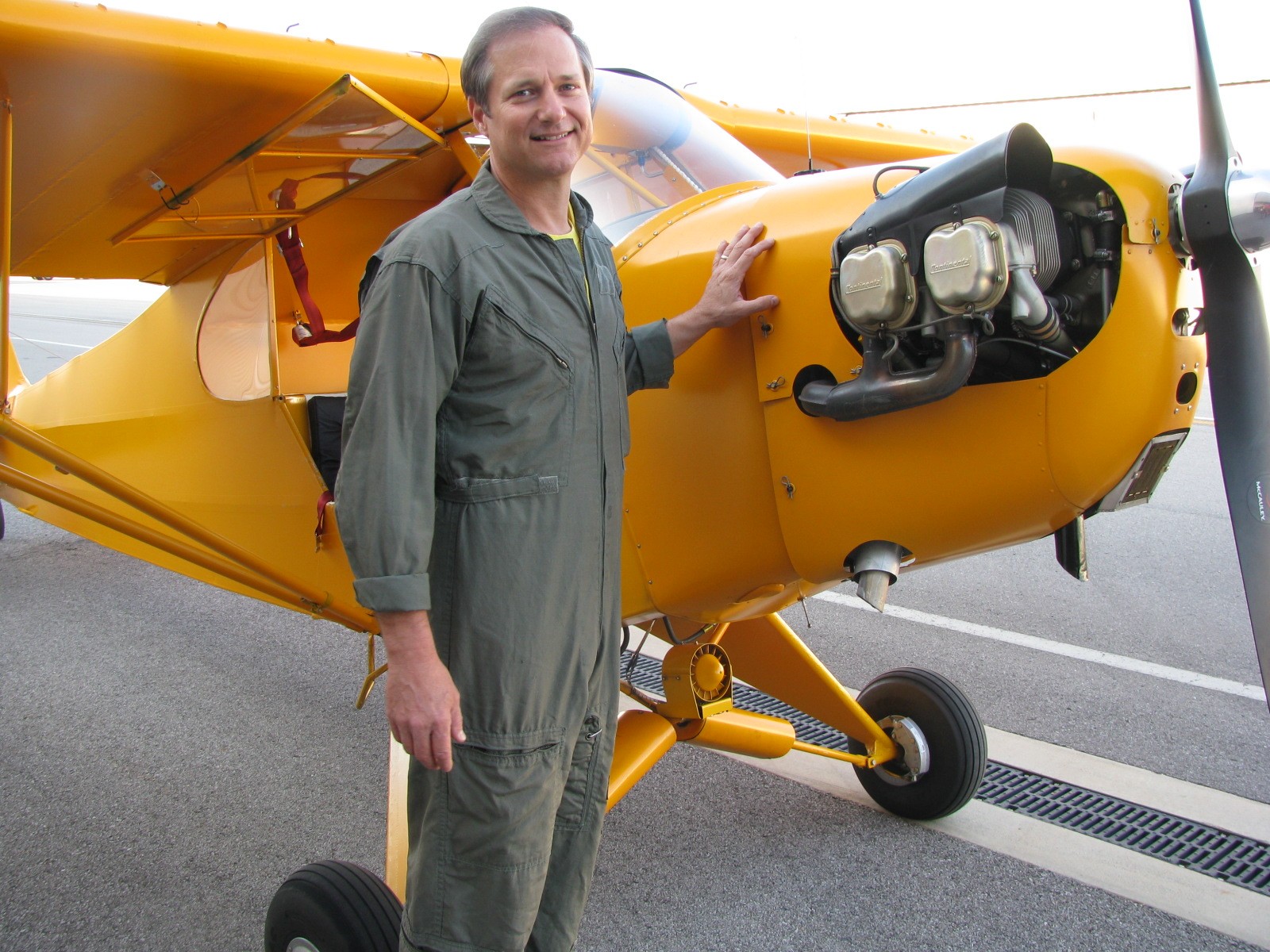
On the front of Paul Johnson's 1969 Pontiac Catalina is a vanity license plate that tells the entire story.
It reads "Lil Arpt."
That's short for Little Airport.
Johnson, a former Navy jet pilot and now an aerospace engineer at Redstone Arsenal, can actually land and take off a 1941 Clipped Wing J-3 Cub from atop the Catalina, thanks to his ace flying abilities, and a specially designed catch and release system.
From spring until November, Johnson and his comedic air show act - complete with airplane landings on the car top, dubbed the "world's shortest airport," and speed races with his 1979 Ford Econoline jet-powered dragster van, called the "world's fastest van" -- are available for small-town, weekend air shows throughout the Southeast. When he isn't flying, Johnson often finds the time to talk with school children in the towns he visits, giving them his own "in-your-face" motivational message of what it takes to make dreams come true.
"I talk to a lot of kids," Johnson said. "My message is about staying in school, staying out of trouble and doing your homework. I only get 'boos' about homework ...
"I tell the kids how I've always wanted to fly airplanes in the Navy, always. I've had six dreams and I've done five of them. I wanted to go to college. I wanted to become a mechanical engineer. I wanted to work in the aerospace industry. I wanted to fly jets for the Navy. I wanted to get married and have a family. My sixth dream is the only one I have doubts about making come true. My sixth dream is to become an astronaut."
He often asks students what their dreams are. Sadly, for Johnson, those dreams involve being a sports star, not pursuing math and science careers.
"It's always the question 'What do you want to be when you grow up'' When they tell me something about being a star football player or a star basketball player, I ask them what their backup plan is going to be," Johnson said.
"Only a fraction of athletes become stars. They have to have a backup plan. They have to have other dreams, too. And, whatever their dream is they have to stay in school and stay out of trouble to make it happen. Elementary and high school are stepping stones to college, college is a stepping stone to a career, and a career is a stepping stone to success and happiness in life."
Johnson hopes his presentations lead some children to look more closely at technological career opportunities. For them, Johnson is a living example of technology success.
In 1982, after completing his degree at the University of Louisville, Johnson began a two-year coop program in the aerospace industry at Redstone Arsenal. He became a full-time employee, but then took a six-year military leave of absence to fly jet aircraft for the Navy.
In 1991, Johnson returned to his aerospace career at Redstone Arsenal. Ten years later, he saw the Cub and Catalina for sale on a website. They had been used in air shows since 1970. With them, Johnson saw an opportunity to reignite his flying days.
He later bought the "world's fastest van" - which can race at speeds up to 300 mph and which comes with a primary parachute, a secondary airchute and an afterburner - on eBay.
Johnson's air show appearances - including shows in Illinois and Kentucky, and last summer's show at Huntsville International Airport -- have been hit and miss over the years. Work obligations, including an assignment as an American diplomat at the U.S. Liaison Office in Moscow for the joint U.S. and Russian space effort, and a work student program at the University of Alabama-Huntsville to earn a master's in engineering management; along with the birth of his now 17-month-old son Arthur have caused Johnson to fly a relatively low profile. But, with plans to expand his air show act, he is now flying high with new ideas to entertain, educate and motivate.
"I'm modernizing the Catalina. We are replacing the 1940s technology of the car top landing act," he said. "The entire car is being rebuilt. We're adding a new engine that will give us a 600 horsepower motor. We've also gutted the plane, and have done some work to make it like brand new, and so it can fly at slower speeds and at night. I've also got a 1938 Taylorcraft airplane that I want to rebuild and add to the act."
Johnson's air show act is marketed under Wright Attitudes, referring to history's Wright brothers and being a play on the need to have the "right attitude" in life. The act provides 12 to 15 minutes of aerobatic entertainment with a comedic twist. Johnson first flies down the runway, trying to attach himself to the top of the Catalina, which is driven by his wife Juliana. At first, he doesn't succeed, but then - on the second pass - there is a connection between the car and plane. After waving to the crowd, Johnson then takes off from the top of the car.
But that's not all. Johnson's act often starts before the aerobatics, and continues during his displays and demonstrations.
"The plane can be strapped down on the top of the car and we can drive through town," Johnson said. "Normal air show pilots show up on Friday, and on Saturday and Sunday they go up to fly and then they're gone. We will come in a few days early, use our airplane to promote the show and go into the schools to talk to kids. The airplane can also tow banners in the sky to promote the air show."
Johnson, a member of the Alabama Wing Civil Air Patrol, first started visiting schools in 1990-91 while in the Navy when the public affairs office asked for pilots to talk to school-age children. On those visits, he would take his pilot's gear to impress the kids and talk to them about realizing their dreams. He continued his school visits as an aerospace engineer and then added them to his air show act.
"I've spoken at over 100 schools in Georgia, Alabama, northern Florida, Tennessee, Illinois and Kentucky," he said.
The kids are often impressed with Johnson; his J-3 Cub, which was used to train military pilots prior to World War II; a live jet engine display and demonstration that shoots a 15-foot flame and brings along a whole lot of noise; and his souped up racing van. He uses his more than 1,400 hours of flying military and civilian aircraft, and his 16 years of work in aviation, aeronautics, aerospace technologies, space sciences, physics, astronomy and mathematics combined with his air show antics to talk to students about what it takes to build a career and be successful in life.
"I have literally boxes of letters from school kids and teachers about what an impression all this makes on them," Johnson said. "No matter if they are young or older students, I hope they get the message that they have to stay in school to make a difference in their own lives. If they are high school students and they are undecided about their lives, I hope this helps them focus on what is important.
"Among the many things I tell them is a story about the nerds in school. I tell them that they may tease the kids who read books and study hard. But someday they will be calling those kids 'Boss.' If they don't get their act together, they may find themselves someday calling those nerdy kids 'Your Honor.' And that's something they definitely want to avoid."
For more information on Johnson's air show act, visit www.wrightattitudes.com.

Social Sharing